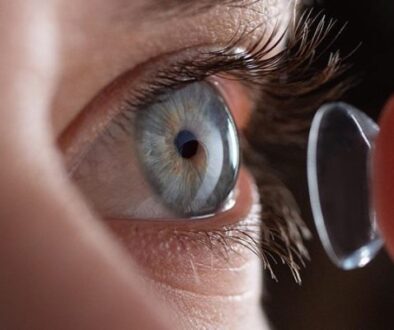Trifocal Lenses: Are These Eyeglasses Right for You?
Struggling with Blurry Vision at Multiple Distances?
If you’re tired of switching glasses for reading, computer work, or driving, trifocal lenses could simplify your daily life. These specialized prescription lenses correct vision at three distances: near (reading), intermediate (computer screens), and far (driving). But how do they work, and are they right for you?
Key Takeaways
- 3 Vision Zones: Correct near (reading), intermediate (screens), and distance (driving) vision in one lens.
- Bifocals vs. Trifocals: Trifocals add intermediate correction (e.g., computers) missing in bifocals.
- Progressive Lenses: Smoother transitions but narrower zones; trifocals offer faster adaptation.
- Who Benefits: Tamarac, FL residents with presbyopia, multitaskers, or computer-heavy routines.
- Types: Eyeglass lenses (daily use) or IOLs (cataract surgery).
- Pros: Eliminates multiple glasses, cost-effective, wider intermediate zones.
- Cons: Visible lines, peripheral distortion, adjustment period.
- Local Solutions: Tamarac clinics offer blended trifocals and anti-glare coatings for Florida’s glare.
- Fitting Matters: Pupillary distance and zone alignment are critical—trust Tamarac opticians.
- Care Tips: Clean daily with microfiber cloth; avoid scratches.
- Cost: 150–400+; check insurance for Tamarac clinic coverage.
- Tech Upgrades: Blue-light filters, lightweight materials, and sharper IOLs.
- When to Try: If switching glasses frustrates you, consult a Tamarac eye expert.
What Are Trifocal Lenses?
Trifocal lenses are precision-designed eyewear with three distinct zones:
-
Near vision (e.g., reading books)
-
Intermediate vision (e.g., viewing computer screens)
-
Distance vision (e.g., recognizing road signs)
Unlike bifocals (which only address near and distance vision), trifocals fill the “in-between” gap. While they have visible lines separating each zone, these lines create quick, predictable transitions—ideal for Tamarac, FL, patients who prioritize functionality over seamless aesthetics.
Trifocals vs. Progressive Lenses: Key Differences
-
Progressive lenses: No visible lines, but gradual transitions can cause distortion.
-
Trifocal lenses: Defined zones reduce adaptation time, ideal for clear intermediate tasks like screen work.
How Trifocal Lenses Work
The design of a trifocal lens includes three segments:
- Top: For distance vision
- Middle: For intermediate tasks like using a computer or cooking
- Bottom: For close-up tasks like reading
These segments are divided by visible lines, helping your eyes shift quickly and accurately between each focal point. The structure makes it easy to move from one viewing range to another without needing to switch glasses.
Who Can Benefit from Trifocal Lenses?
These multifocal lenses are especially beneficial for:
- People with presbyopia, a natural age-related decline in near vision
- Individuals with multiple vision issues, like farsightedness and nearsightedness
- Professionals and frequent computer users who need clear intermediate vision throughout the day
Types of Trifocal Lenses
Trifocals come in two main forms:
- Eyeglass lenses: Common for everyday use and available through most opticians
- Intraocular lenses (IOLs): Implanted during cataract surgery to provide vision correction without the need for glasses
Lined Trifocal Lenses: Pros and Cons
Lined (segmented) trifocals have distinct advantages and drawbacks:
Pros
- Faster focus shifts between near, intermediate, and distance tasks.
- Cost-effective for Tamarac patients needing a reliable screen and driving vision.
Cons
- Aesthetic concerns: Visible lines may feel less modern.
- Limited intermediate zone width compared to premium progressives.
Lined trifocals work best for those prioritizing function over style. Schedule a free lens demo at a Tamarac clinic to compare options side by side.

Advantages of Trifocal Lenses
- Clear vision at all distances, reducing the need to switch between different glasses
- Wider intermediate viewing area than progressive lenses
- Convenient for multitasking, such as driving, reading, and using digital screens
- Cost-effective for those who would otherwise need multiple prescriptions
One of the biggest benefits is clear vision at all distances—near, intermediate, and far—which significantly reduces the need to switch between different pairs of glasses throughout the day. They also provide a wider intermediate viewing area compared to progressive lenses, making them especially helpful for tasks like using a computer or cooking. This makes trifocals a great option for multitasking, whether you’re driving, reading, or moving between various activities. Additionally, they can be a cost-effective solution for those who would otherwise require multiple prescriptions or pairs of glasses.
Disadvantages of Trifocal Lenses
While trifocals simplify multifocal vision, consider these limitations:
- Visible lines: The segmented design can feel outdated compared to seamless progressives.
- Peripheral distortion: Side vision may blur when looking outside the zones.
- Longer adaptation: Some Tamarac patients need weeks to adjust, especially if new to multifocals.
Solutions for Tamarac, FL Residents
- Ask local opticians about “blended trifocals” with softer line transitions.
- Pair lenses with anti-glare coatings for clearer vision during Florida’s sunny days.
Fitting Process and Customization
Proper fitting is essential for trifocal glasses to work effectively. An eye care professional will measure your pupillary distance and determine the best placement for each viewing zone. While trifocals don’t offer as much blending as progressives, there are still some customization options in terms of lens shape and frame compatibility.
Custom Trifocal Lenses: Precision Vision for Tamarac Lifestyles
By Dr. Brianna Rhue, FAAO – Board Certified Optometric Physician
Your trifocal lenses shouldn’t be one-size-fits-all. At our Tamarac practice, we customize every prescription to match how you actually use your vision – driving local roads, working on computers, or pursuing hobbies.
Personalized Trifocal Solutions for Tamarac Patients:
- Work-Specific Designs
Office Professionals: Wider intermediate zones for seamless screen-to-document transitions
Drivers: Anti-glare coatings with distance optimization for I-595/Sawgrass Expressway glare
Crafters & Hobbyists: Expanded near zones for detailed close-up work - Lifestyle Enhancements
Active Adults: Featherlight impact-resistant materials
Travelers: Scratch-resistant coatings for frequent luggage handling - Vision Condition Support
Astigmatism: Dual-correction lenses (presbyopia and astigmatism)
Digital Strain: Blue light filters for prolonged device use
Trifocals vs. Other Vision Correction Options
- Bifocals: Trifocals add an intermediate section for tasks like computer use, which bifocals lack
- Progressive lenses: Offer a smooth, gradual transition between distances but may have narrower viewing zones and require more adaptation
- Trifocals: are often preferred by those who want distinct zones without the learning curve of progressives
Care and Maintenance
To keep your trifocal lenses in top shape:
- Clean daily with a microfiber cloth and lens-safe cleaner.
- Store them in a hard case when not in use.
- Avoid wiping lenses with paper towels or clothing to prevent scratches.
With proper care, trifocal lenses can last for several years, depending on your prescription needs and lens material.
Cost and Insurance Considerations
The cost of trifocal lenses varies based on materials, coatings (like anti-glare or blue light protection), and whether you choose eyeglasses or IOLs. Fortunately, many vision insurance plans cover part of the cost. If you’re considering IOLs, check if your medical insurance includes cataract surgery options.
Technological Advancements in Trifocal Lenses
Today’s trifocal lenses are more advanced than ever. Improved lens materials, anti-reflective coatings, and even blue-light filtering options make them more comfortable and durable. For those undergoing cataract surgery, trifocal IOLs now offer sharper, more natural vision than older models.
Looking ahead, innovations in smart lenses and adaptive materials may make trifocals even more responsive to individual visual needs.
When to Consider Trifocal Lenses
If you’re tired of switching glasses for reading, working, and driving—or if you’re dealing with presbyopia and other vision challenges—it might be time to talk to your eye care provider about trifocal lenses. A professional can assess your lifestyle and prescription needs to determine if they’re the right fit for you.
In Summary
Trifocal lenses offer a convenient, all-in-one solution for people who need help seeing at multiple distances. Whether in eyeglasses or as part of cataract surgery, they can significantly improve your quality of life by reducing visual strain and simplifying your routine.
FAQ: Trifocal Lenses
-
Trifocal lenses correct near, intermediate, and distance vision, while bifocals only address near and far. They’re ideal for Tamarac, FL residents who need clear vision for tasks like computer work or reading menus at local cafes.




